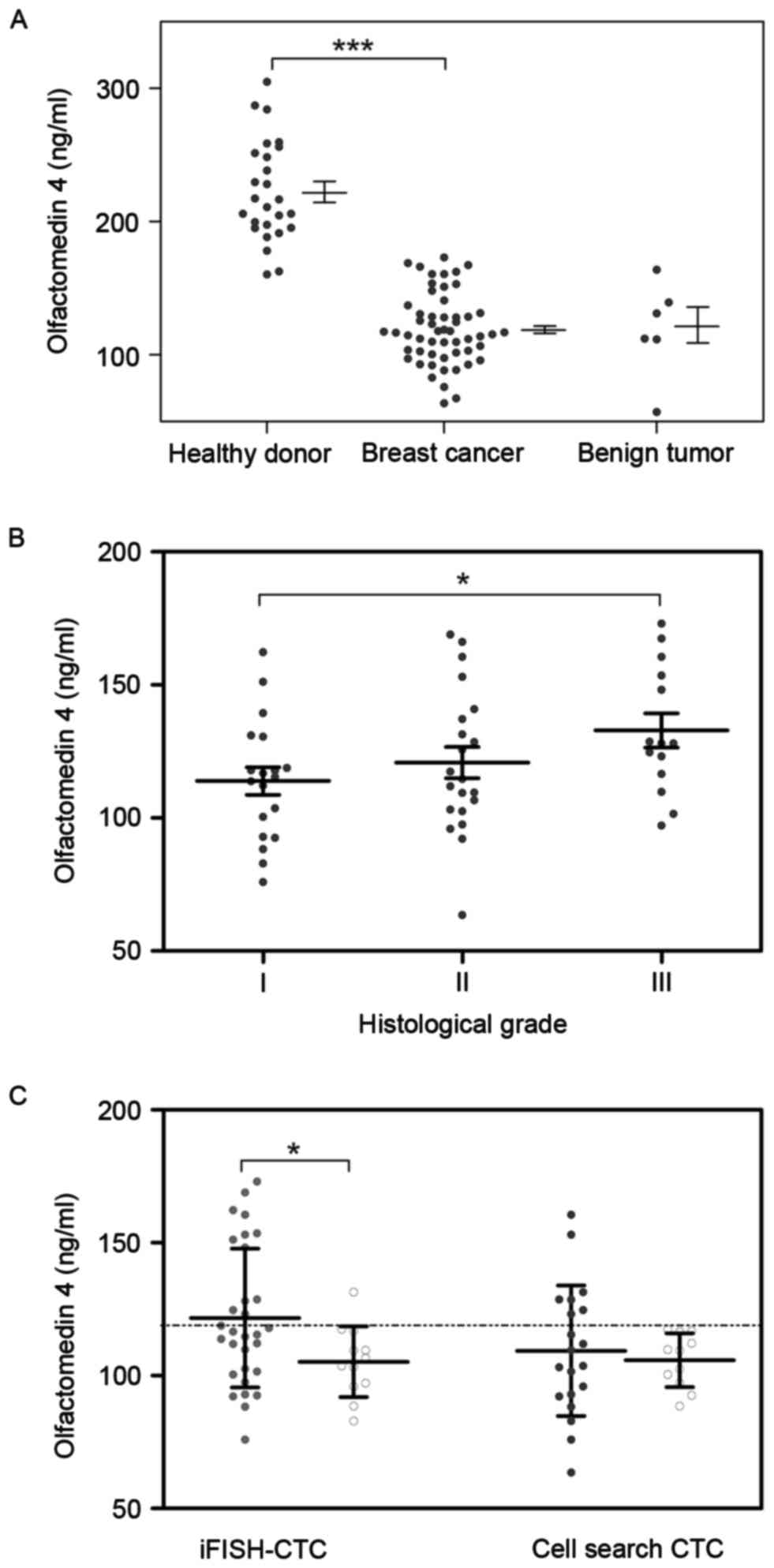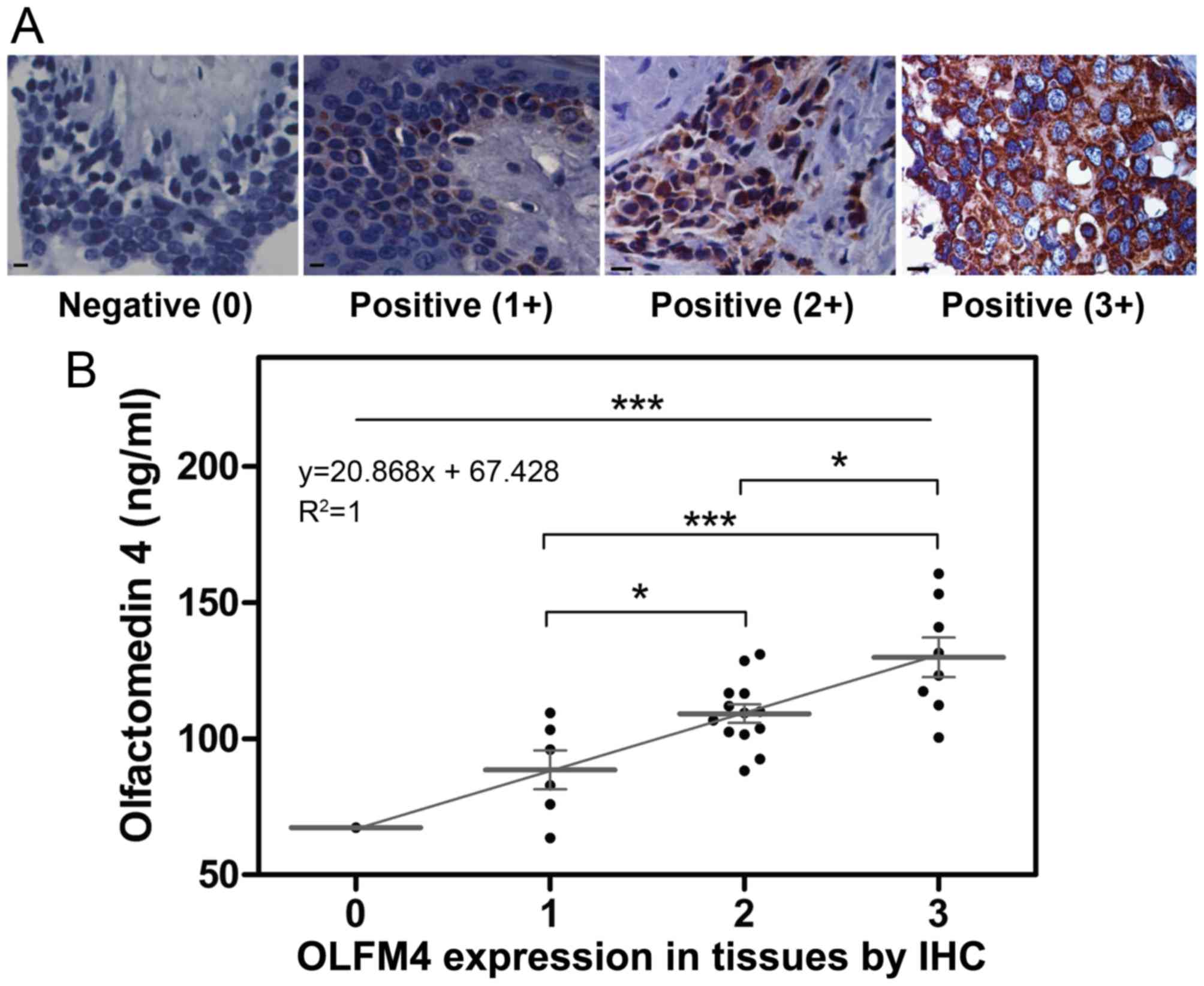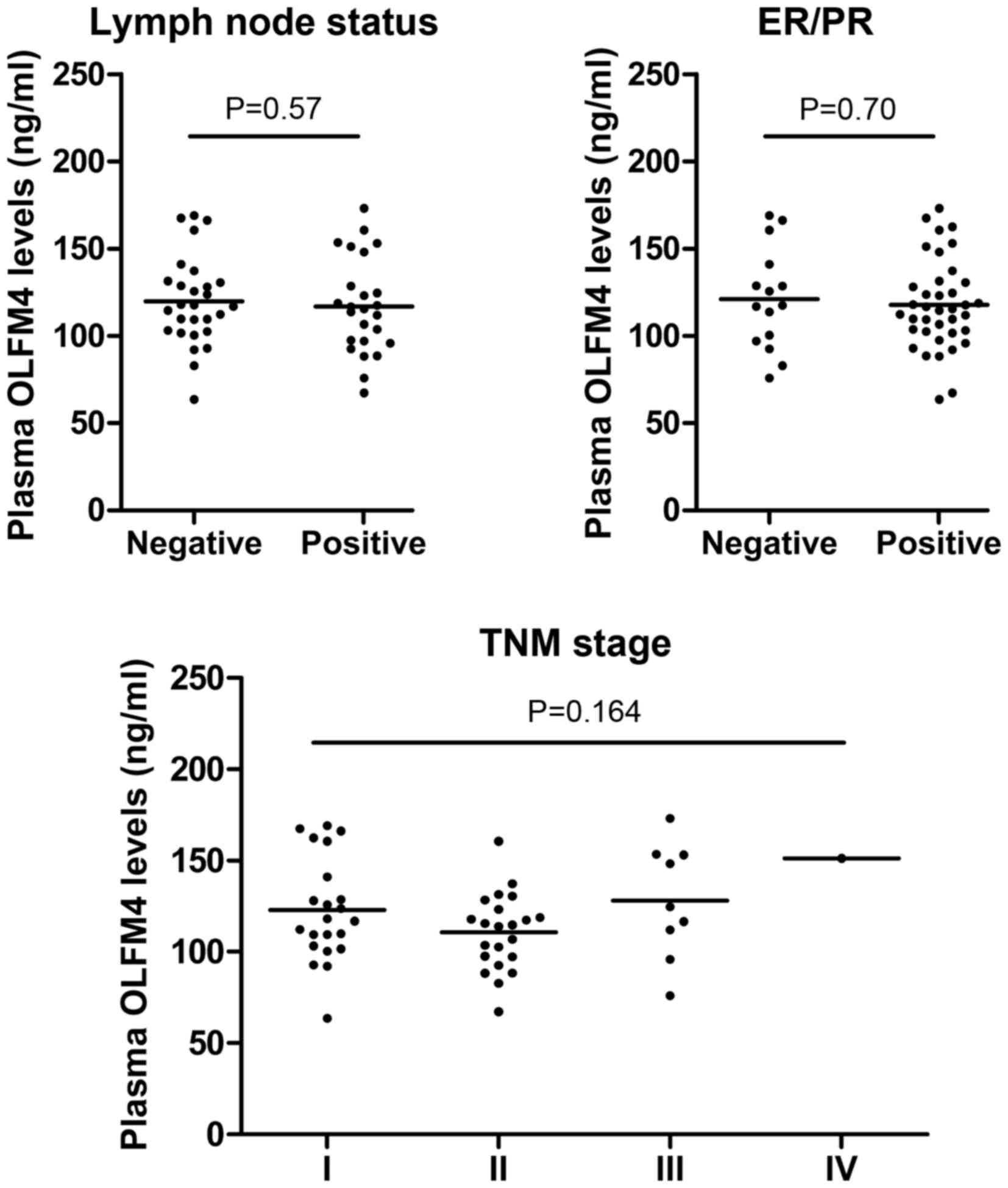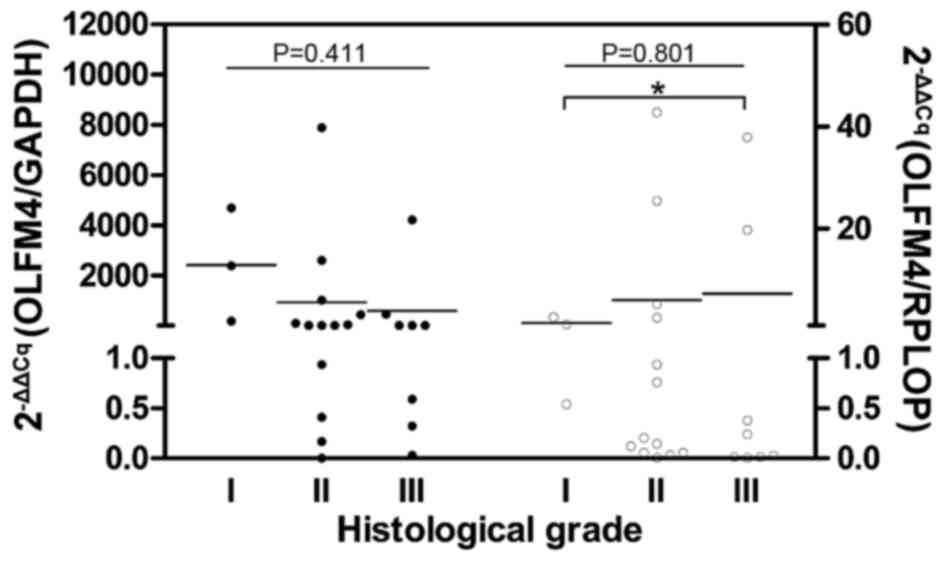|
1
|
Grover PK, Hardingham JE and Cummins AG:
Stem cell marker olfactomedin 4: Critical appraisal of its
characteristics and role in tumorigenesis. Cancer Metastasis Rev.
29:761–775. 2010. View Article : Google Scholar : PubMed/NCBI
|
|
2
|
Kulkarni NH, Karavanich CA, Atchley WR and
Anholt RR: Characterization and differential expression of a human
gene family of olfactomedin-related proteins. Genet Res. 76:41–50.
2000. View Article : Google Scholar : PubMed/NCBI
|
|
3
|
Zhang J, Liu WL, Tang DC, Chen L, Wang M,
Pack SD, Zhuang Z and Rodgers GP: Identification and
characterization of a novel member of olfactomedin-related protein
family, hGC-1, expressed during myeloid lineage development. Gene.
283:83–93. 2002. View Article : Google Scholar : PubMed/NCBI
|
|
4
|
Tomarev SI and Nakaya N: Olfactomedin
domain-containing proteins: Possible mechanisms of action and
functions in normal development and pathology. Mol Neurobiol.
40:122–138. 2009. View Article : Google Scholar : PubMed/NCBI
|
|
5
|
Besson D, Pavageau AH, Valo I, Bourreau A,
Bélanger A, Eymerit-Morin C, Moulière A, Chassevent A,
Boisdron-Celle M, Morel A, et al: A quantitative proteomic approach
of the different stages of colorectal cancer establishes OLFM4 as a
new nonmetastatic tumor marker. Mol Cell Proteomics.
10:M111.0097122011. View Article : Google Scholar : PubMed/NCBI
|
|
6
|
Huang Y, Yang M, Yang H and Zeng Z:
Upregulation of the GRIM-19 gene suppresses invasion and metastasis
of human gastric cancer SGC-7901 cell line. Exp Cell Res.
316:2061–2070. 2010. View Article : Google Scholar : PubMed/NCBI
|
|
7
|
Kobayashi D, Koshida S, Moriai R, Tsuji N
and Watanabe N: Olfactomedin 4 promotes S-phase transition in
proliferation of pancreatic cancer cells. Cancer Sci. 98:334–340.
2007. View Article : Google Scholar : PubMed/NCBI
|
|
8
|
Liu W, Liu Y, Zhu J, Wright E, Ding I and
Rodgers GP: Reduced hGC-1 protein expression is associated with
malignant progression of colon carcinoma. Clin Cancer Res.
14:1041–1049. 2008. View Article : Google Scholar : PubMed/NCBI
|
|
9
|
Park KS, Kim KK, Piao ZH, Kim MK, Lee HJ,
Kim YC, Lee KS, Lee JH and Kim KE: Olfactomedin 4 suppresses tumor
growth and metastasis of mouse melanoma cells through
downregulation of integrin and MMP genes. Mol Cells. 34:555–561.
2012. View Article : Google Scholar : PubMed/NCBI
|
|
10
|
Koshida S, Kobayashi D, Moriai R, Tsuji N
and Watanabe N: Specific overexpression of OLFM4 (GW112/HGC-1) mRNA
in colon, breast and lung cancer tissues detected using
quantitative analysis. Cancer Sci. 98:315–320. 2007. View Article : Google Scholar : PubMed/NCBI
|
|
11
|
Oue N, Sentani K, Noguchi T, Ohara S,
Sakamoto N, Hayashi T, Anami K, Motoshita J, Ito M, Tanaka S, et
al: Serum olfactomedin 4 (GW112, hGC-1) in combination with Reg IV
is a highly sensitive biomarker for gastric cancer patients. Int J
Cancer. 125:2383–2392. 2009. View Article : Google Scholar : PubMed/NCBI
|
|
12
|
Yu L, He M, Yang Z, Chen G, Li M, Wang L
and Chen S: Olfactomedin 4 is a marker for progression of cervical
neoplasia. Int J Gynecol Cancer. 21:367–372. 2011. View Article : Google Scholar : PubMed/NCBI
|
|
13
|
Chen L, Li H, Liu W, Zhu J, Zhao X, Wright
E, Cao L, Ding I and Rodgers GP: Olfactomedin 4 suppresses prostate
cancer cell growth and metastasis via negative interaction with
cathepsin D and SDF-1. Carcinogenesis. 32:986–994. 2011. View Article : Google Scholar : PubMed/NCBI
|
|
14
|
Yan H, Lu D, Xu L, Xie Q, Dong X and Wu Y:
Increased expression level of Olfactomedin4 in peripheral blood
mononuclear cells of pancreatic adenocarcinoma patients.
Hepatogastroenterology. 58:1354–1359. 2011. View Article : Google Scholar : PubMed/NCBI
|
|
15
|
Huang MY, Wang HM, Chang HJ, Hsiao CP,
Wang JY and Lin SR: Overexpression of S100B, TM4SF4, and OLFM4
genes is correlated with liver metastasis in Taiwanese colorectal
cancer patients. DNA Cell Biol. 31:43–49. 2012. View Article : Google Scholar : PubMed/NCBI
|
|
16
|
Huang MY, Wang HM, Tok TS, Chang HJ, Chang
MS, Cheng TL, Wang JY and Lin SR: EVI2B, ATP2A2, S100B, TM4SF3, and
OLFM4 as potential prognostic markers for postoperative Taiwanese
colorectal cancer patients. DNA Cell Biol. 31:625–635. 2012.
View Article : Google Scholar : PubMed/NCBI
|
|
17
|
Xiong B, Lei X, Zhang L and Fu J: The
clinical significance and biological function of olfactomedin 4 in
triple negative breast cancer. Biomed Pharmacother. 86:67–73. 2017.
View Article : Google Scholar : PubMed/NCBI
|
|
18
|
Amin MB, Edge SB, Greene FL, Schilsky RL,
Gaspar LE, Washington MK, Sullivan DC, Brookland RK, Brierley JD,
Balch CM, et al: AJCC (American Joint Committee on Cancer) Cancer
Staging Manual. 8th edition. Springer; Chicago: 2017, View Article : Google Scholar
|
|
19
|
Li Y, Zhang X, Ge S, Gao J, Gong J, Lu M,
Zhang Q, Cao Y, Wang DD, Lin PP and Shen L: Clinical significance
of phenotyping and karyotyping of circulating tumor cells in
patients with advanced gastric cancer. Oncotarget. 5:6594–6602.
2014. View Article : Google Scholar : PubMed/NCBI
|
|
20
|
Zhang Y, Wang F, Ning N, Chen Q, Yang Z,
Guo Y, Xu D, Zhang D, Zhan T and Cui W: Patterns of circulating
tumor cells identified by CEP8, CK and CD45 in pancreatic cancer.
Int J Cancer. 136:1228–1233. 2015. View Article : Google Scholar : PubMed/NCBI
|
|
21
|
Cristofanilli M, Budd GT, Ellis MJ,
Stopeck A, Matera J, Miller MC, Reuben JM, Doyle GV, Allard WJ,
Terstappen LW and Hayes DF: Circulating tumor cells, disease
progression, and survival in metastatic breast cancer. N Engl J
Med. 351:781–791. 2004. View Article : Google Scholar : PubMed/NCBI
|
|
22
|
Livak KJ and Schmittgen TD: Analysis of
relative gene expression data using real-time quantitative PCR and
the 2(-Delta Delta C(T)) Method. Methods. 25:402–408. 2001.
View Article : Google Scholar : PubMed/NCBI
|
|
23
|
Abayomi K, Gelman A and Levy M:
Diagnostics for multivariate imputations. Series C Appl Stat.
57:273–291. 2008. View Article : Google Scholar
|
|
24
|
Conover WJ: Practical nonparametric
statistics. 2nd edition. New York: Wiley; 1980
|
|
25
|
Yu L, Wang L and Chen S: Olfactomedin 4, a
novel marker for the differentiation and progression of
gastrointestinal cancers. Neoplasma. 58:9–13. 2011. View Article : Google Scholar : PubMed/NCBI
|
|
26
|
Snyder DA, Rivers AM, Yokoe H, Menco BP
and Anholt RR: Olfactomedin: Purification, characterization, and
localization of a novel olfactory glycoprotein. Biochemistry.
30:9143–9153. 1991. View Article : Google Scholar : PubMed/NCBI
|
|
27
|
Liu W, Yan M, Liu Y, Wang R, Li C, Deng C,
Singh A, Coleman WG Jr and Rodgers GP: Olfactomedin 4
down-regulates innate immunity against Helicobacter pylori
infection. Proc Natl Acad Sci USA. 107:pp. 11056–11061. 2010,
View Article : Google Scholar : PubMed/NCBI
|
|
28
|
Révillion F, Pawlowski V, Hornez L and
Peyrat JP: Glyceraldehyde-3-phosphate dehydrogenase gene expression
in human breast cancer. Eur J Cancer. 36:1038–1042. 2000.
View Article : Google Scholar : PubMed/NCBI
|
|
29
|
Radonić A, Thulke S, Mackay IM, Landt O,
Siegert W and Nitsche A: Guideline to reference gene selection for
quantitative real-time PCR. Biochem Biophys Res Commun.
313:856–862. 2004. View Article : Google Scholar : PubMed/NCBI
|
|
30
|
Takadate T, Onogawa T, Fukuda T, Motoi F,
Suzuki T, Fujii K, Kihara M, Mikami S, Bando Y, Maeda S, et al:
Novel prognostic protein markers of resectable pancreatic cancer
identified by coupled shotgun and targeted proteomics using
formalin-fixed paraffin-embedded tissues. Int J Cancer.
132:1368–1382. 2013. View Article : Google Scholar : PubMed/NCBI
|
|
31
|
Liu RH, Yang MH, Xiang H, Bao LM, Yang HA,
Yue LW, Jiang X, Ang N, Wu LY and Huang Y: Depletion of OLFM4 gene
inhibits cell growth and increases sensitization to hydrogen
peroxide and tumor necrosis factor-alpha induced-apoptosis in
gastric cancer cells. J Biomed Sci. 19:382012. View Article : Google Scholar : PubMed/NCBI
|
|
32
|
Suh YS, Lee HJ, Jung EJ, Kim MA, Nam KT,
Goldenring JR, Yang HK and Kim WH: The combined expression of
metaplasia biomarkers predicts the prognosis of gastric cancer. Ann
Surg Oncol. 19:1240–1249. 2012. View Article : Google Scholar : PubMed/NCBI
|
|
33
|
de Kok JB, Roelofs RW, Giesendorf BA,
Pennings JL, Waas ET, Feuth T, Swinkels DW and Span PN:
Normalization of gene expression measurements in tumor tissues:
Comparison of 13 endogenous control genes. Lab Invest. 85:154–159.
2005. View Article : Google Scholar : PubMed/NCBI
|
|
34
|
Lyng MB, Laenkholm AV, Pallisgaard N and
Ditzel HJ: Identification of genes for normalization of real-time
RT-PCR data in breast carcinomas. BMC Cancer. 8:202008. View Article : Google Scholar : PubMed/NCBI
|
|
35
|
Gresner P, Gromadzinska J and Wasowicz W:
Reference genes for gene expression studies on non-small cell lung
cancer. Acta Biochim Pol. 56:307–316. 2009.PubMed/NCBI
|
|
36
|
Caradec J, Sirab N, Keumeugni C, Moutereau
S, Chimingqi M, Matar C, Revaud D, Bah M, Manivet P, Conti M and
Loric S: ‘Desperate house genes’: The dramatic example of hypoxia.
Br J Cancer. 102:1037–1043. 2010. View Article : Google Scholar : PubMed/NCBI
|
|
37
|
Liu W, Chen L, Zhu J and Rodgers GP: The
glycoprotein hGC-1 binds to cadherin and lectins. Exp Cell Res.
312:1785–1797. 2006. View Article : Google Scholar : PubMed/NCBI
|













